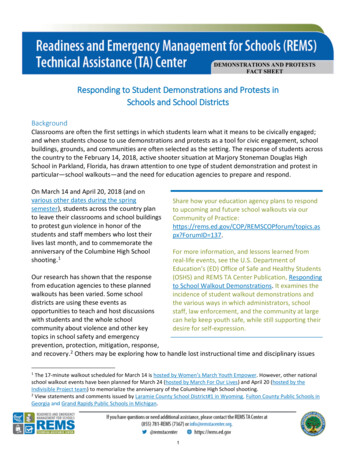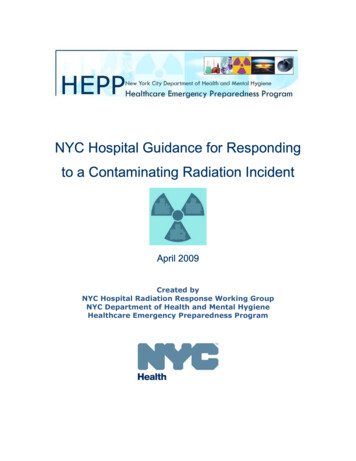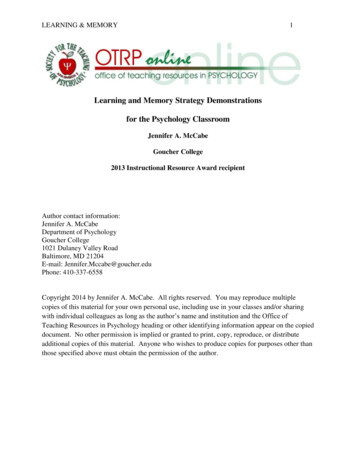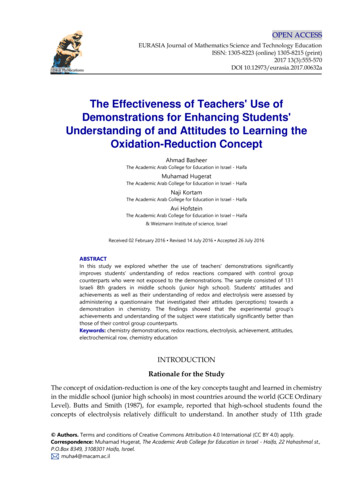
Transcription
DEMONSTRATIONS AND PROTESTSFACT SHEETResponding to Student Demonstrations and Protests inSchools and School DistrictsBackgroundClassrooms are often the first settings in which students learn what it means to be civically engaged;and when students choose to use demonstrations and protests as a tool for civic engagement, schoolbuildings, grounds, and communities are often selected as the setting. The response of students acrossthe country to the February 14, 2018, active shooter situation at Marjory Stoneman Douglas HighSchool in Parkland, Florida, has drawn attention to one type of student demonstration and protest inparticular—school walkouts—and the need for education agencies to prepare and respond.On March 14 and April 20, 2018 (and onvarious other dates during the springsemester), students across the country planto leave their classrooms and school buildingsto protest gun violence in honor of thestudents and staff members who lost theirlives last month, and to commemorate theanniversary of the Columbine High Schoolshooting. 1Share how your education agency plans to respondto upcoming and future school walkouts via ourCommunity of cs.aspx?ForumID 137.For more information, and lessons learned fromreal-life events, see the U.S. Department ofEducation’s (ED) Office of Safe and Healthy Students(OSHS) and REMS TA Center Publication, Respondingto School Walkout Demonstrations. It examines theincidence of student walkout demonstrations andthe various ways in which administrators, schoolstaff, law enforcement, and the community at largecan help keep youth safe, while still supporting theirdesire for self-expression.Our research has shown that the responsefrom education agencies to these plannedwalkouts has been varied. Some schooldistricts are using these events asopportunities to teach and host discussionswith students and the whole schoolcommunity about violence and other keytopics in school safety and emergencyprevention, protection, mitigation, response,and recovery. 2 Others may be exploring how to handle lost instructional time and disciplinary issuesThe 17-minute walkout scheduled for March 14 is hosted by Women’s March Youth Empower. However, other nationalschool walkout events have been planned for March 24 (hosted by March For Our Lives) and April 20 (hosted by theIndivisible Project team) to memorialize the anniversary of the Columbine High School shooting.2View statements and comments issued by Laramie County School District#1 in Wyoming, Fulton County Public Schools inGeorgia and Grand Rapids Public Schools in Michigan.11
DEMONSTRATIONS AND PROTESTSFACT SHEETthat may result from the demonstrations. Many education agencies are likely working with communitypartners to balance the need to ensure continuity of learning and operations, as well as whole schoolcommunity safety and security, while still encouraging the interest among youth on civic engagementand school safety.Students may feel the need to participate in ademonstration or protest for a number of reasons, suchas perceptions that their views are not being takenseriously or seriously enough; being called to actionafter exposure to information, messages and imagesfrom corollary media coverage following emergencyevents3; or based on their own personal responses toand opinions regarding social and political trends orevents. In some scenarios, students may feel compelledto plan and lead their own protest or demonstration inthe school environment. In these situations, schoolsStudents from Sacred High Academy high school andmay want to consider the following:local community members hold a demonstration Whether it would be appropriate for the school about levee repairs at Jackson Square in New Orleans,to set up a safe space for students to protest, or Louisiana. Source: Federal Emergency Managementto work with local officials to find a safe space in Institute Image Librarythe community for student protests; Whether school or local police should accompany students in protest; How to protect school and community property in collaboration with community partners; How to handle lost instructional time; Whether and under what circumstances disciplinary action may be required; How to ensure that the learning environment of students who are not participating indemonstrations is not disrupted; How to ensure students who wish to participate in demonstrations have a safe place to expresstheir concerns and be civically engaged; and How to engage with families to help reinforce expectations of students, and discuss possibleresponses to protests.While demonstrations and protests (and the themes and events that prompted them) can cause highlevels of emotion, including fear and anxiety, there are many steps education agencies can take to helpFor information on disaster media coverage, its effects on students, and detailed ways to help students cope with disastermedia coverage, see Disaster Media Intervention. Helping Students Cope with Disaster Media Coverage: A Guide forTeachers and School Staff, Disaster and Community Crisis Center, University of Missouri.32
DEMONSTRATIONS AND PROTESTSFACT SHEETstudents, staff, and the whole school community process the event; express their feelings; andstrengthen coping skills and resilience under the guidance and care of the adults, educators,administrators, and partners who support them every day. Ultimately, finding constructive ways todebrief and discuss these types of events and the issues surrounding them supports a positive schoolclimate in which students and staff feel safe to express their feelings and perspectives, and createslearning opportunities around real-world events.Incorporating Plans to Respond to Student Demonstrations in School Emergency OperationsPlans (EOPs)Demonstrations and protests like school walkouts impact theentire school community, including students, teachers, staff,and families. From safety and mental and behavioral healthto continuity of learning and operations, schools (public andnonpublic) and school districts may have to address andsupport students and staff in a variety of areas whenresponding to planned demonstrations and protests. Forschool administrators and emergency planning teams, thiscan seem daunting. However, pre-planning—especially withcommunity partners—using the six-step planning processoutlined in the Guide for Developing High-Quality SchoolEmergency Operations Plans (School Guide) can help ensurethe whole community stays safe.Using the Six-Step Planning Process to PlanSchools and school districts are also encouraged to examine their EOPs when real-world emergencyevents happen to ensure they are prepared for resulting demonstrations and protests that may occuron their school campus or within their community. Federal partners in school emergencypreparedness, including the U.S. Departments of Education, Homeland Security, Justice, Health andHuman Services, and the Federal Emergency Management Agency and Federal Bureau of Investigation,recommend that schools and school districts use existing safety, security, and emergency managementefforts in conjunction with the six-step planning process described in the School Guide to review,revise, and create EOPs. The following section provides examples of how the six-step planning processcan be used to incorporate planning for student walkout demonstrations into an EOP.Step 1: Form a Collaborative Planning Team: In this first step, the planning team is formed, comprisedof a core planning team, school personnel and community partners, including law enforcement, and adistrict representative. In planning for these types of events, it is critically important for schools to3
DEMONSTRATIONS AND PROTESTSFACT SHEETwork with partners, both district and school-based, as well as those on the community level. Otherrelevant planning partners may include educators, counselors, administrators, facilities managementstaff, as well as local municipality government officials (e.g.,mayor’s office, permit office), the local traffic division, andthe District Attorney’s office.Step 2: Understand the Situation: Here, the planning teamuses a variety of assessments to identify possible threatsand hazards to the school, such as violence or propertydamage resulting from student protests, and to assess therisk and vulnerabilities posed by them. One tool that maybe especially useful in this context is a Culture and ClimateAssessment that measures students’ connectedness to theschool and teachers and staff. ED provides several SchoolClimate Surveys that measure three domains ofengagement, safety, and the environment. Surveys areavailable for middle and high school students, instructionalstaff, non-instructional staff, and parents/guardians. (Moreinformation on the topic of school climate is available in thearchived OSHS and REMS TA Center Webinar How PositiveSchool Climate Can Enhance School Safety.)SIX-STEP PLANNING PROCESS Step 1: Form a collaborativeplanning team. Step 2: Understand the situation. Step 3: Determine goals andobjectives. Step 4: Plan development (identifycourses of action). Step 5: Plan preparation, review,and approval. Step 6: Plan implementation andmaintenance.A Site Assessment, such as one conducted using the OSHSand REMS TA Center SITE ASSESS tool, may also help determine the level of safety and security within aschool’s building and/or grounds. For example, it might help in the process of identifying certain areasthat would be better than others for protests to occur, so the school can help direct students to saferlocales. (More information on Crime Prevention Through Environmental Design [CPTED], whichemphasizes how to use environmental design to help improve safety and security, is discussed in moredetail in the Key Considerations section below.)Step 3: Determine Goals and Objectives and Step 4: Plan Development (Identifying Courses ofAction): The work conducted in Step 2 will reveal that several threats, such as demonstrations andprotests, and cross cutting activities/functions, such as security4 and communication 5, will need to beaddressed by the EOP. Goals, which are broad statements, can then be created by the planning teamfor desired outcomes before, during, and after each threat and function. Objectives can be establishedSee the Bureau of Justice Administration’s resource Managing Large Scale Security Events: A Planning Primer for LawEnforcement for more information on the role of law enforcement in planning for events of this type.5More information is available in the Social Media and Tactical Considerations For Law Enforcement report (see page 41)by U.S. Department of Justice Community Oriented Policing Service and Police Executive Research Forum.44
DEMONSTRATIONS AND PROTESTSFACT SHEETthat are specific and measurable actions to achieve each of these goals, and courses of action are thendeveloped to accomplish the objectives. When thinking through the courses of action (or, the who,what, when, where, why, and how of accomplishing the objectives) for planning, it is important toconsider the key planning principle of considering all settings and all times. For this type of event, thismay include whether student demonstrations and protests will be On, nearby, and/or off campus; Sanctioned and unsanctioned; and/or Before, during, and after the school day.Also, consider the role of virtual communication and cyber capabilities; whether for spreading theword or extending protests, the virtual/cyber setting and these tools must be considered. It is alsoimportant to think through the possible themes and prompts for these kind of events, such as courtcases, media events, and board decisions.Step 5: Plan Preparation, Review, and Approval: In this step, a draft of the EOP is written, includingthreat- and hazard-specific and functional annexes. Goals, objectives and courses of action related tostudent demonstrations and protests would likely be included in a threat-specific annex, but theplanning team can decide where that information fits best within the EOP based on the needs of theschool community and partners who play a role in implementing the plan. The draft is then reviewedby senior leadership and approved.Step 6: Plan Implementation and Maintenance: Finally, the plan is implemented, which includesproviding training to teachers, staff, and administrators on their roles and responsibilities during ademonstration or protest, and conducting emergency exercises to test the school’s response.Whenever possible, find opportunities for student leaders and stewards to play an active role inplanned trainings and exercises.Key Considerations in the Planning ProcessCrime Prevention Through Environmental Design (CPTED)CPTED is a multi-disciplinary strategic approach to deterring criminal behavior and protecting theschool community. It can be applied to all protective measures, as described below. Natural Surveillance. This strategy allows for unobtrusive observation of a particular settingthrough design features that maximize visibility of people, parking areas, and buildingentrances such as doors and windows that look out on to streets and parking areas. School staffcan work with facilities and grounds management staff to develop as clear a view as possible ofits most critical areas, including all possible entry and exit points of the building and its5
DEMONSTRATIONS AND PROTESTSFACT SHEETsurroundings, and the areas where a demonstration or protest might take place. Anotherexample is having staff or partners positioned in key areas, collectively surveying the entirecampus. Territorial Reinforcement. This strategy restricts who may enter or exit the grounds, a facility, acorridor, or room by defining property lines and distinguishing private spaces from publicspaces. Strategies can include landscape plantings, pavement designs, fences, lines, and signs.In consideration of demonstrations, different types of entrance procedures (e.g., stop, & signin), parking designations (e.g., lower lot, off campus), and partitions. Natural Access Control. The third strategy demonstrates ownership and respect for property bydesigning streets, sidewalks, building entrances, and neighborhood gateways to clearly indicatepublic routes and by discouraging access to private areas via structural elements such asdesignated visitor parking with signs pointing visitors to the front office to sign in, and signsdesignating restricted areas of the building and grounds. Actively controlling access to andmonitoring a school’s grounds and entrances help guard against unauthorized and unwantedentry to the facility and works to support many safety, security, and emergency managementefforts. The focus of controlling access is to ensure that only members and authorized personsmay be on the grounds and in the building. Creating a complementary system to continuallymonitor the facility and its surroundings strengthens this protective effort. Target Hardening. This final strategy prohibits entry or access through features such as windowlocks, dead bolts for doors, and interior door hinges. And, for the campus, gates, patrols, andpartitions.Emergency management planning teams at education agencies should work in close collaboration withtheir facilities management teams to implement CPTED approaches before, during, and afterdemonstrations and protests to enhance safety.6Addressing Issues of Controversy to Promote a Positive School ClimateSchools and school districts can also create broader educational opportunities to examine the issuesbrought up by the events that prompt student demonstrations and protests. For example, schools andschool districts may consider ways to integrate current events into the curriculum: History, government, social studies or civics classes could:o Examine the historical context of issues brought up;For more information on CPTED and Site Assessment Resources, see the OSHS and REMS TA Center Webinar DesigningSafe Schools: Planning and Retrofitting for Safety in Education Facilities.66
DEMONSTRATIONS AND PROTESTSFACT SHEET o Lead a lesson on non-violent protests; or,o Discuss First Amendment rights to free speech.Homeroom classes could facilitate open discussions on relevant topics so students canconstructively discuss differing viewpoints.English or creative writing classes could encourage journaling or free writing on relevant topics.Classes focused on use of information technology can emphasize responsible civic engagementin online settings (both in and out of the classroom).Schools and school districts can also integrate comprehensive violence prevention programming, toinclude trauma-informed care, prosocial instructions, conflict resolution, and restorative justice. Ineach educational setting, it is important for teachers to establish ground rules for discussing sensitivetopics; showing respect; and maintaining a safe space for students to express their thoughts, feelings,or perspectives.Key ResourcesIn addition to the materials identified above, other materials of note include: School EOPs In-Depth: Planning for Large Events (OSHS & REMS TA Center). Trainings on thistopic are available as a specialized training package, which includes a PowerPoint presentationwith speaker notes, resource guide, and tabletop exercise, and in an online format. Thetrainings cover activities such as how to understand a school’s vulnerability from large eventsand how to plan for them. Building Trauma-Informed Communities for Youth Webinar (OSHS and National Center on SafeSupportive Learning Environments). In this archived event, presenters discuss howdemonstrations and protests can traumatize students and how to take a trauma-informedapproach in youth-serving systems. Civil Unrest Tabletop Exercise (Texas School Safety Center). This PowerPoint presentation,available in the REMS TA Center Tool Box, introduces emergency exercises and providesscenarios and questions for a civil unrest event. The Tool Box is an interactive and virtual libraryof tools developed by emergency manager practitioners in the field and containing relevantresources pertinent to the needs of local education agencies, schools, and their communitypartners as they engage in the process of emergency preparedness planning.To learn how other education agencies have planned for and responded to school walkouts and otherdemonstrations and protests, view the following resources. Demonstration/Student Unrest (State of Iowa) p.29. The 2012 Iowa School Safety Guide,developed as a template to assist schools in Iowa enhance their safety programs and created bynine state and local agencies, including Iowa Department of Education, Iowa Homeland Security7
DEMONSTRATIONS AND PROTESTSFACT SHEET and Emergency Management, and Iowa Department of Public Safety offers the EmergencyResponse Flip Chart content for Demonstration/Student Unrest.Navigating Student Walkouts & Mass Protests (National School Boards Association). This outlineprovides recommendations for schools in a checklist format, and also details possible schoolwalkout scenarios.OSBA Student Protest Guidance (Oregon School Boards Association). This Web page providesanswers to commonly asked questions from educators and administrators about how torespond to school walkouts.Procedures for Handling Disturbances, or Demonstrations on or Adjacent to School Sites, (LosAngeles Unified School District). This sample policy bulletin offers lessons learned and anexample of a school district policy addressing relevant issues.Submit tools you use to prepare for and respond to student demonstrations andwalkouts to our Tool eSubmissions.aspx8
word or extending protests, the virtual/cyber setting and these tools must be considered. It is also important to think through the possible themes and prompts for these kind of events, such as court cases, media events, and board decisions. Step 5: Plan Preparation, Review, and Approval: In this step, a draft of the EOP is written, including










